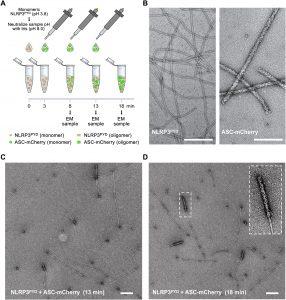Inflammation can be experienced as redness, swelling or pain, all mechanisms of protecting the body from infection and injury. In a recent paper by Hochheiser, et al., they showed that a specific protein, NLRP3, involved in inflammatory reactions, develops in a specific pattern during inflammation. This finding may allow for the inhibition or possible stopping of inflammatory processes through effective manipulation (READ MORE).
NLRP3 is activated as a “sensor,” protein following infection from bacterial or viral pathogens or from other foreign substances (READ MORE). This protein also has some implications in the onset of Alzheimer’s disease. Inflammation which has been triggered by NLRP3 activation, promotes the production and spread of amyloid-ß plaques, thus contributing to the pathogenesis of the disease. Several NLRP3 proteins attach to each other to form a mass which represents a thread-like structure with a nucleus on which more proteins will attach.
In this present paper, the researchers were able to show the direction and degree of which the structure/filament expands using cryo-electron microscopy. Through small additions of NLRP3, they were able to visualise how the structure develops following attachment of new NLRP3 proteins following each addition (Figure 1).

Figure 1: ASC filament polymerization on NLRP3PYD nucleation seeds. (A) Cartoon depiction of an NLRP3PYD-induced ASC filament polymerization assay. Filament formation of monomeric NLRP3PYD is induced by neutralization to pH 8.0. Stepwise titration of highly diluted ASC-mCherry leads to the elongation on NLRP3 filament seeds. (B) Negative-stain electron micrographs of NLRP3PYD (left) and ASC-mCherry filaments (right). Scale bars, 200 nm. (C) Elongation of ASC-mCherry filaments on NLRP3PYD filament seeds after the first two titration steps. Several thin NLRP3PYD filaments are seen out of which thicker ASC-mCherry filaments grow out. Note that, at the most, one transition is seen from an NLRP3 to an ASC filament, suggesting a directionality of filament growth. Scale bar, 200 nm. (D) Elongation of the ASC-mCherry filament on NLRP3PYD seeds after three titration steps. Increasing the ASC concentration induces ASC filaments to grow longer on the NLRP3PYD nucleation seeds. Scale bar, 200 nm (Hochheiser, et al., 2022).
Their findings allow for the targeting inhibition of inflammation through targeting the development of NLRP3 filaments/structures. This may allow us to reduce or stop chronic inflammation.
Journal article: Hochheiser, I.V., et al., 2022. Directionality of PYD filament growth determined by the transition of NLRP3 nucleation seeds to ASC elongation. Science Advances.
Summary by Stefan Botha










